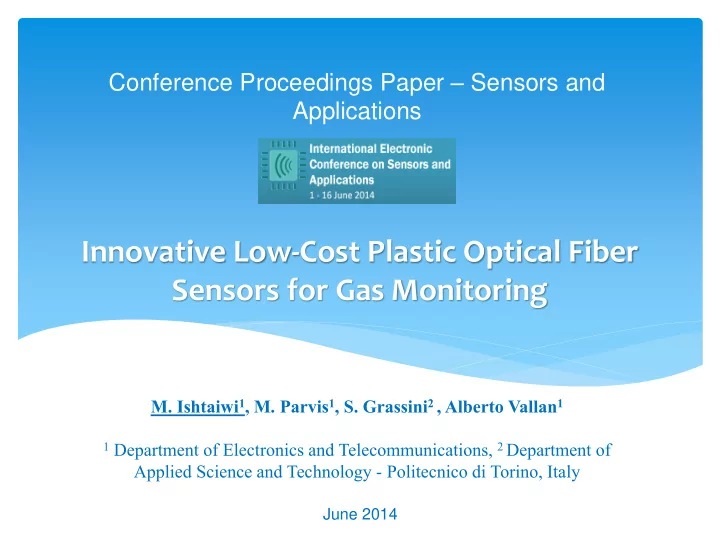

Conference Proceedings Paper – Sensors and Applications Innovative Low-Cost Plastic Optical Fiber Sensors for Gas Monitoring M. Ishtaiwi 1 , M. Parvis 1 , S. Grassini 2 , Alberto Vallan 1 1 Department of Electronics and Telecommunications, 2 Department of Applied Science and Technology - Politecnico di Torino, Italy June 2014
Plastic Optical Fibers (POF) o POF consists of: • PMMA Core : (Polymethyl-methacrylate) 980 µm, refractive index = 1.49 • Fluoropolymer cladding : up to 1000 µm, refractive index = 1.40 • Coating jacket : to protect the cladding-core structure. o POF Features Large core diameter (0.25 – 1 mm) & High Numerical Aperture (NA = 0.5) • High light collecting capability • Easy to align and to connectorize PMMA core (polymer) • Easy to handle • Easy to cut • Low cost POF Multi Mode • Low cost optical sources, non-coherent source (LED)
Fiber Preparation and Sensor Design - I commercial Ethylacetate Fiber ends Removing the step-index POF were polished (40 sec) cladding by using with grinding Ethylacetate paper Sensor Assembly is composed of: plastic fiber with length about of 10 cm, a light The fiber is cured in an oven at emitting diode (LED), and a photodiode (PD). 60 – 70 ° C for 60 hours to ensure complete polymerization of the liquid PMMA
Fiber Preparation and Sensor Design - II Sensor assembly bonded to a PMMA support Intrinsic POF Sensor Low cost: less than 1 € Small sensor dimension Easy to obtain high detection capabilities via cumulative output responses Capability to use the same fiber both for sensing and transmission Under harsh environments: Strong electromagnetic field (EMF) High temperature Chemical environments Ionizing radiation
Fiber Preparation and Sensor Design - III 1. Removing of the fiber cladding - ( ethylacetate ) not more than 40 second; avoiding damaging the PMMA core. increase the sensitivity FESEM image shows that on a fiber etched for 40 s the cladding has been completely removed without affecting the PMMA core structure.
Fiber Preparation and Sensor Design - V 2. Deposition onto the fiber core of a sensitive layer capable of reacting with the gas “ HF vapors ” by means low-pressure PECVD Plasma Enhanced Chemical Vapor Deposition (PECVD) Reactor
Fiber Preparation and Sensor Design - IV SiO x layer (a glass- like layer) SiO x by PECVD of organosilicon compounds @ 5 Pa, 50 - 100 W supplied power TEOS + Ar + O 2 13.56 MHz RF power generator TEOS: Tetra-Ethyl-Ortho-Silicate monomer 200 nm Fiber inside PECVD reatocr FESEM image SiOx
Sensor Working Principle SiO x coated fiber The chemical reaction between the sensitive layer (glass- like ) and the pollutant (HF vapors) must alter the fiber light HF vapor transmittance capability. HF solution
Sensor Measurement Set-up
Experimental Results - 1 1. Exposition to HF Photodiode current change due to the HF reaction on the SiOx layer deposited on the fiber. It is clear how the degradation of SiOx layer due to HF results in an increase of the photodiode current. The current increases until the external coating reaches a stable degradation state after about 25 h.
Experimental Results - 2 Coated fiber response to HF exposition. Top trace: The temperature during the test measured with the Pt100 sensor. Middle trace: exposition computed as the integral of the vapor concentration. Bottom trace: fiber transmittance ratio normalized to its initial value.
Experimental Results - 3 3. Fiber non-texturing effect Nano-textured Coating glass- like Exposing to HF Uncladding PMMA Nano-textured 1 0.96 0.069 0.69 fiber Non treated fiber 1 0 0.059 0.11 The nano-textured PMMA core fiber, which has a high equivalent surface area with respect to the non treated fiber, significantly increases the sensors sensitivity compared to untreated PMMA surface core.
Conclusions • Plasma modified POF can be successfully used to detect of fluoride concentration in gas mixtures. • POF sensor able to detect low concentrations of hydrogen fluoride (ppm). • The sensors are cumulative so they directly measures the total exposure to HF vapors. • Sensor prototypes showed a good sensitivity. • The nano-textured PMMA core fiber, significantly increases the sensors sensitivity compared to untreated PMMA surface core.
Thank You very much
Recommend
More recommend